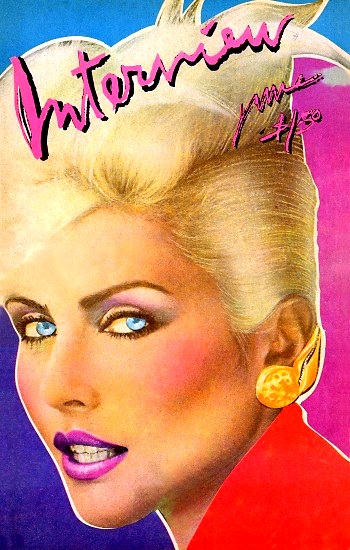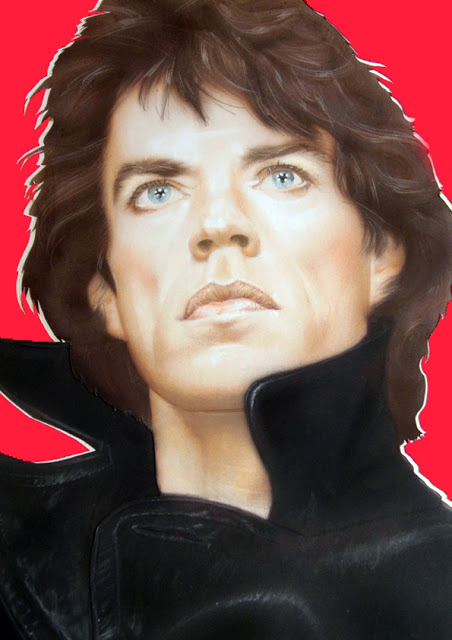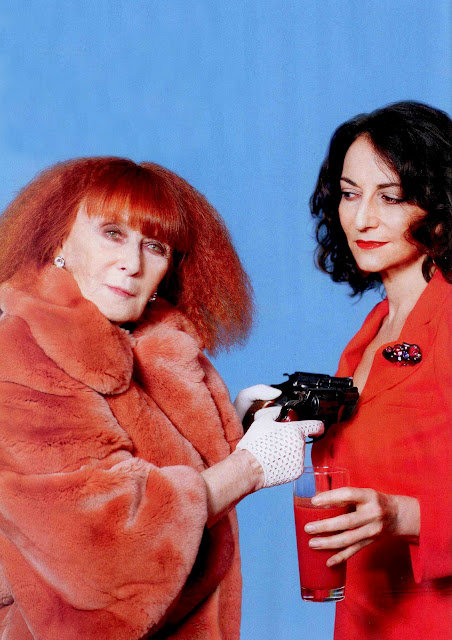
Acetate mechanical for 82-inch Flowers, 1964. Ink on acetate, handwritten ink on Bristol board, overall
 Photo of hibiscus flowers by Modern Photography executive editor Patricia Caulfield, published in that magazine in 1964 where it was found and used by Andy Warhol
Photo of hibiscus flowers by Modern Photography executive editor Patricia Caulfield, published in that magazine in 1964 where it was found and used by Andy Warhol

 Warhol in a field of black-eyed Susans with an early Flowers canvas, Queens, New York, 1964. Photo: John William Kennedy
Warhol in a field of black-eyed Susans with an early Flowers canvas, Queens, New York, 1964. Photo: John William Kennedy
 Warhol with his assistants Philip Fagan (left), and poet Gerard Malanga (right). At the Factory, 231 East 47th Street, New York, 1964.
Warhol with his assistants Philip Fagan (left), and poet Gerard Malanga (right). At the Factory, 231 East 47th Street, New York, 1964.
 Warhol working on a large Flower painting at the Factory, New York City, March 1965.
Warhol working on a large Flower painting at the Factory, New York City, March 1965.
 Andy Warhol, Flowers, 1964, acrylic and silkscreen on linen, 24 x 24 in. each (16 works shown).
Andy Warhol, Flowers, 1964, acrylic and silkscreen on linen, 24 x 24 in. each (16 works shown).
At the 1964 New York World’s Art Fair, the architect Phillip Johnson commissioned 10 artists to make large-scale works to adorn the facade of the State Pavilion—a monument Johnson had designed as a celebration of human advancement. Robert Indiana, Roy Lichtenstein, James Rosenquist, and Robert Rauschenberg were among the Pop artists selected. Andy Warhol was another contributor. However, Warhol’s piece Thirteen Most Wanted Men, which depicted silkscreened mug shots of real criminals, was censored—covered with silver paint, and never seen by the public.
Was this event the catalyst for Warhol’s transition from felons to florals? The flower, a symbol of fragility and purity, is antithetical to the blunt violence associated with the criminal. The art historian Michael Lobel eloquently explores this collision of themes in Warhol’s work in his essay Andy Warhol Flowers: a fitting accompaniment to the comprehensive survey of Warhols’ Flowers paintings.
Warhol’s flower paintings, created between 1964 and 1965, were initially inspired by a photograph of several hibiscus flowers taken by Patricia Caulfield, then the executive editor of Modern Photography magazine. The foldout article depicted how a new Kodak home color processing system could manipulate color. Warhol appropriated the image without permission, cropped, copied, enhanced the contrast, and eventually settled on a square format that meant the paintings could be viewed from any orientation. Caulfield, by-the-way, sued Warhol for copyright infringement and it was settled out of court. We get to see Caulfield’s original photograph that was printed in Modern Photography magazine along with many of Warhol’s variations on it in paint, silkscreen and collage on a wide range of materials. A collection of these paintings was the focus of Warhol’s first show at the prestigious Leo Castelli Gallery in late 1964, and signaled his ascension into the legitimized art world.
 Dress designed by Halston, 1972
Dress designed by Halston, 1972
 Diane Von Fürstenberg Spring Summer 2012 collection
Diane Von Fürstenberg Spring Summer 2012 collection
 WHO’S AFRAID OF VIRGINIA WOOLF (1966)
WHO’S AFRAID OF VIRGINIA WOOLF (1966)




































 Peter Som, United Bamboo, Imitation of Christ, Jeffrey Chow, Behnaz Sarafpour and Sebastian Pons
Peter Som, United Bamboo, Imitation of Christ, Jeffrey Chow, Behnaz Sarafpour and Sebastian Pons










